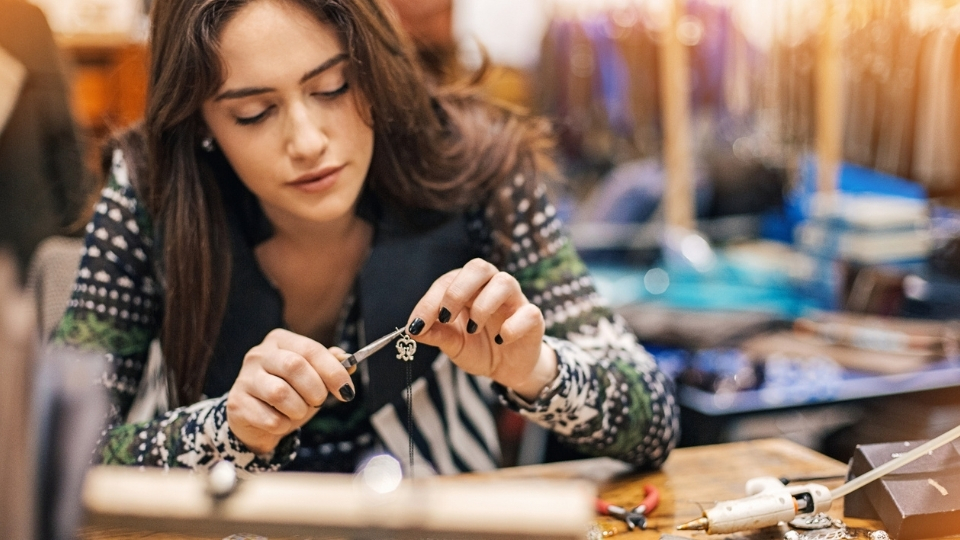What are people buying online in 2025? Microtrends to watch for your start-up
Staff Writer | October 14, 2025

Hyper-personalised jewellery and accessories are a growing microtrend.

This article was made possible thanks to Gibson Gifts, Australia’s leading giftware wholesaler selling exclusively to retailers, with a range of products and brands to suit all niches.
The Australian e-commerce scene is booming. With 80 per cent of households shopping online and the market heading towards $58 billion by 2029, there’s plenty of opportunity.
But while everyone’s chasing viral trends, smart entrepreneurs are building businesses around microtrends that most people haven’t spotted yet.
So what exactly are Australians buying when they’re not grabbing the obvious bestsellers? Let’s explore the microtrends quietly reshaping consumer spending and creating real opportunities for start-up founders.
Microtrends vs fads: What’s the difference?
A fad explodes overnight and disappears just as quickly – remember fidget spinners?
A microtrend builds momentum gradually over months or years, driven by genuine lifestyle changes rather than hype.
Microtrends matter because they offer three key advantages:
- Sustainable demand based on real behaviour shifts
- Less competition from established brands, who often miss early opportunities
- Higher margins as customers pay premium prices for products that solve real problems.
The smart money isn’t on predicting next week’s viral hit; it’s on identifying slow-burning trends that will define consumer behaviour for years to come.
5 microtrends creating opportunities in 2025
1. Wellness tech that actually delivers
Gone are the days of basic fitness trackers. Consumers want sophisticated health monitoring that provides actionable insights, not just data dumps.
Gen Z prioritises appearance alongside health, while millennials focus more on mindfulness. Both groups are investing in smart sleep devices, personalised nutrition apps, and wearables that track recovery rather than just steps.
The opportunity? Create wellness tech that solves specific problems. Think devices for shift workers struggling with sleep patterns, or apps helping busy parents optimise their energy levels throughout the day.
2. Hyper-personalised accessories
Mass production is losing appeal as consumers seek products reflecting their individual identity. This goes beyond simple monogramming—people want truly unique items that tell their personal story.
Consumers particularly love personalised accessories connecting them to local places. Consider products incorporating meaningful coordinates, custom phone cases matching specific decor, or jewellery featuring Australian gemstones in personalised designs.
The key is offering genuine customisation that goes deeper than surface-level personalisation.
3. The men’s lifestyle revolution
Here’s a microtrend flying under the radar: Australian men are becoming more discerning shoppers, especially in categories traditionally dominated by women.
Men are trending towards self-care and grooming, but this extends into home decor, wellness products, and novelty items that reflect personality over function. The wholesale gifts for him market is evolving from generic “man cave” items to sophisticated products acknowledging men’s diverse interests.
Smart entrepreneurs are creating premium products without pretension, such as artisanal hot sauce subscriptions, sophisticated bar accessories, and skill-building hobby kits that feel like personal development.

4. Sustainable home goods that actually work
Environmental consciousness has moved beyond token gestures. Research shows that 64 per cent of consumers rank sustainability as a key value driver, with 80 per cent willing to pay 9.7 per cent more for eco-friendly products.
But here’s the crucial point: today’s consumers won’t accept “good for the planet” if it means “bad for my lifestyle”. They want sustainable products that outperform conventional alternatives.
Create home goods delivering superior functionality while being environmentally responsible. Think bamboo kitchen utensils that are more durable than plastic, or cleaning products that work better than chemicals while being biodegradable.
Consumers especially value products supporting local ecosystems — items made from native materials or contributing to conservation efforts.
5. Micro-convenience solutions
As life gets busier, consumers pay for solutions to very specific problems. These aren’t major life changes—they’re small frustrations creating big opportunities.
Successful products include portion-controlled herb gardens for apartment dwellers, cable management for remote workers, and storage solutions for hobby enthusiasts to help maximise small spaces.
The key is identifying common but underserved pain points. What minor annoyances do people complain about regularly? Often, the best products solve problems people didn’t realise they had.
Why start-ups should focus on microtrends
Traditional market research misses microtrends because they start small and grow gradually. By the time they appear in major reports, early opportunities are gone.
Microtrends offer several start-up advantages:
- Lower competition before markets become saturated
- Higher margins through premium pricing while establishing the market
- Authentic branding when genuinely solving emerging problems
- Scalable learning about customer behaviour patterns.
The most successful entrepreneurs spot changes early and adapt quickly.
Finding your own microtrends
Want to identify microtrends in your market? Start by watching the edges of mainstream trends. What are early adopters doing that seems odd but makes sense?
Look for changes in how people use existing products, not just what they’re buying. Are people repurposing items unexpectedly? Are they combining products from different categories?
Pay attention to complaints and workarounds. When people jerry-rig solutions or express consistent frustration, that’s often where microtrends begin.
Most importantly, focus on trends aligning with broader societal shifts. Lasting microtrends connect to deeper changes in how people work, live, or prioritise their lives.
Interest rate relief expected in 2025 will boost consumer spending, but households remain cautious after drawing into savings during cost-of-living pressures. This environment actually favours microtrends over fads: thoughtful consumers gravitate towards products solving real problems and aligning with their values.
The entrepreneurs thriving in 2025 won’t necessarily have the biggest marketing budgets or most viral products. They’ll be the ones who spotted genuine consumer behaviour shifts early and built solutions that grow with customers’ evolving needs.
Microtrends will shape e-commerce’s future. The question is, will you be ready to capitalise when they do?
Sponsored

This article was made possible thanks to Gibson Gifts, Australia’s leading giftware wholesaler selling exclusively to retailers, with a range of products and brands to suit all niches.
We have a request
SHE DEFINED’s journalism is independent and we’re committed to elevating the voices of women by putting them front-and-centre in our stories and giving them a platform to speak up.
Quality journalism and editorial content takes time, money and resources to create, which is why your support matters. We don’t have a paywall or exclusive subscriptions because we believe in keeping our stories open to everyone.
Help support our mission by making a financial contribution today.






